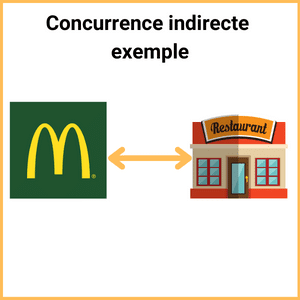What is indirect competition? Definition
Indirect competition refers to a situation where two or more companies offer different products or services, but meet the same customer needs. Their objectives are therefore similar. These services provide an equivalent level of satisfaction for the end customer. The companies are therefore competing in different but similar markets.
Indirect competition is different from direct competition. The latter occurs when two or more companies offer essentially the same product or service in the same place, or are available in the same place. Directly competing companies compete for the same market.
Examples of indirect competition
Indirect competition can be found in everyday life.
To better understand this concept, let’s take an example, focusing here on the fast-food market.

Two fast-food outlets like McDonald’s or Burger King will be in direct competition, as they offer the same products and services.
However, these restaurants are also in competition with others, such as traditional restaurants, food-trucks, cafeterias and sandwich shops. These other restaurants are indirect competitors: they don’t sell fast-food, but they do sell food, which can be substituted for fast-food.
In this example, we can clearly see that competition doesn’t have to be direct to have a real competitive impact on a company’s business.
Another example: in the building and civil engineering sector, Point.P, a retailer of equipment for professionals, will face direct competition from Gedimat, Tout Faire Matériaux and Chausson Matériaux. Another form of indirect competition could be the BtoB services offered by other DIY stores, such as Leroy Merlin or Castorama, which normally focus on private customers.
Why analyze your indirect competition?
Keeping an eye on your competition, whether direct or indirect, is essential to ensuring you become (and stay!) competitive in your sector or market. You can better understand how your competitors meet the needs of their customers or prospects, what arguments they use, or what new products they offer… Essential for the success of your business!
Contrary to popular belief, indirect competition can be just as formidable in some markets as direct competition. Just because a competitor doesn’t sell exactly what you offer doesn’t mean they can’t bite into your potential sales revenue!
Recently, for example, with the rise in fuel prices, many consumers have been rounding up electric bikes as an alternative way of getting around, rather than the car. So, although they’re not in direct competition, bicycle manufacturers can nibble away at the market share of car manufacturers. Hence the acceleration of the latter’s research to produce cleaner vehicles, while remaining financially affordable!
English translation of indirect competition
The English translation of direct competition is indirect competition.
What's the competition like as a traveling salesman?
As a traveling salesperson, competition can come in many forms. There may be direct competitors offering the same products or services as you, but there may also be indirect competition from products or services that can fulfill the same needs as yours.
It’s important to understand your market and your competition to identify potential opportunities and challenges. It can be useful to research your competitors to find out what they offer, at what price and how they position themselves in the market. This can help you develop a strategy to differentiate your products or services and sell them more effectively.
It can also be useful to develop sales and marketing skills to set yourself apart from the competition. For example, you can emphasize customer service, the quality of your company’s or your principal’s products, or their originality, to stand out from the competition. If you’re a salaried employee or multi-brand sales agent, don’t hesitate to ask your employer’s or principal’s marketing department for advice: they’re sure to have support and resources to help you stand out from the crowd!


